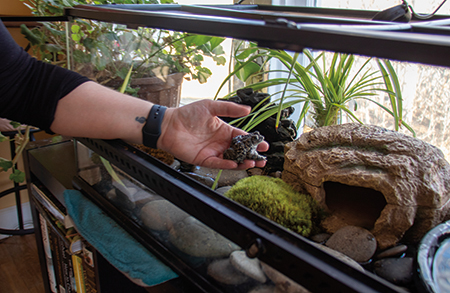Assistant professor's and student's research cures boreal toads of deadly fungus
Batrachochytrium dendrobatidis (Bd) is a fungus few can pronounce, let alone have ever heard of. But for one Colorado Mesa University assistant professor, these words are part of her everyday vocabulary as she traverses canyons and national forests in order to stop the eradication of boreal toads in the American west.
Like a lot of kids, biology faculty member Denita Weeks, PhD, grew up playing with frogs. She became captivated
with amphibians from an early age as a result of her parents having their own fascination with exotic creatures.
“We had a lot of different pets growing up, so I grew accustomed to creepy crawlies early on,” laughed Weeks. “We had iguanas. We had an alligator at one point.”
By the age of 10, she had heard about a deadly fungus that was killing populations of frogs throughout the world.
“I wanted to save them,” said Weeks. “As I started to become more educated about them, I was really fascinated by their physiology. They have a lot of unique things about their body that are different from other animal groups.”

By the time Weeks arrived at CMU in 2018, she was well versed in the aquatic fungus responsible for decimating the boreal toads in the region. She spent the summer of 2019 in canyons testing different water sources in search of invasive bull frogs that were carrying the infection and spreading it, but which were otherwise unaffected.
Colorado Parks and Wildlife invited her to join a boreal toad conservation group. She volunteered to start a research project that would later save a large group of infected boreal toads.
“I wanted to help any way I could, and I wanted to get CMU students involved in the research,” said Weeks.
By April 2020, more than 100 toads were kept in individual containers on the CMU campus. With COVID-19 protocols in place, student Marie Bates joined Weeks in her research.
“She fell in love with the little toads because they’re pretty adorable and she learned how to handle them, how to swab their skin and check for the fungus,” said Weeks.
Together, they performed intense rounds of treatment to clear the toads of the fungus. They bathed each amphibian in an anti-fungal solution for five minutes every day for 10 days.
“Because it is a chemical that kills a fungus and amphibians absorb everything through their skin some animals don’t handle the treatment well, so some of them didn't make it but the majority of them did,” said Weeks.
Of the ones that survived, Weeks and Bates saw a 100% success rate and more than 70 toads were later released back into the wild.
Weeks’ and Bates’ research continued to the Grand Mesa where only one known breeding population is left, and they reintroduced toads to a new location in order to repopulate.
Weeks is looking to get more students involved in 2021. She plans to continue her research this summer to determine why some boreal toad populations can live with the fungus while others cannot.
